Internet of things wireless communications expert: How to choose the battery
Internet of things wireless communications expert: How to choose the battery?
Wi-Fi is the world's most widely used local area network connection communication protocol, in mobile phones, computers, tablets and other mainstream consumer electronics terminals have become the standard configuration. With the rapid decline of chip cost and the improvement of lithium battery security, WI-FI Internet of things applications are widely used, including intelligent sweeping robots, air conditioning, intelligent cameras, intelligent sockets and so on. According to IDC, worldwide shipments of WiFi chips will reach 4.9 billion by 2022, accounting for more than 40 percent of the shipments of major internet solutions and one of the most important connections for the Internet of things.
Wifi products for the Internet of things are also popular. For example, particle-photon Wi-Fi with a connector, a granular internet of things panel that uses a Lipo battery, provides everything a user needs to build a connection project. Thanks to plug-ins, it makes prototyping simple and easy. It has an open source design, a real-time operating system, a particle WIFI module and RGB leds, and a pre-welded joint. Another example is the ultra-high-performance home Wi-Fi System Netgear Orbi, an extremely powerful Internet of things device powered by lithium polymer batteries or household power, which maintains a home-wide network of WI-FI systems, be able to cover an entire house with fast WI-FI.
How do you choose a battery for a WiFi Iot device?
First of all, we need to understand that the battery discharge capacity is not infinite, not that the capacity is large enough on the line. So in the choice of battery, according to the power consumption of equipment to judge. like The battery capacity, Lisocl2 Battery AA Er14505 battery capacity of about 2600 mAh. This capacity means that if the LiSOCL2 battery is attached to a device that consumes 2,600 mA, the battery can work for an hour.
Lithium batteries are also customizable, and their capacity is proportional to their size. If the manufacturer tells you that a 1,000 mAh battery has a discharge capacity of 0.5 C, then the discharge current is 1,000 * 0.5 = 500 mA; if it's 2C, then the battery has a discharge capacity of 0.5C, that's 1000 times 2 = 2A. Therefore, the discharge capacity of lithium battery is related to the battery capacity. Therefore, in the design of products, must be clear about the required battery discharge capacity! Compared with ordinary lithium polymer batteries, Iot batteries need to achieve large capacity, wide temperature range and long standby time.
Some Iot products even need large pulse current, SER GROUP has developed a number of targeted battery packs, such as lithium thionyl chloride battery, lithium thionyl chloride plus supercapacitors, soft package Limno2 thin battery, CP Battery, and unique low self-discharge design ideas, the overall capacity and service life of the battery has been greatly enhanced, the new lithium-manganese battery flexible packaging technology, greatly improved safety, lithium-thionyl chloride battery plus super capacitor to make the battery pulse power more powerful, remote control is more durable.
With the wide application of lithium thionyl chloride-supercapacitor batteries and lithium manganese softpack batteries in Internet of things (iot) products, it is believed that more and more iot products will come into our lives in the near future





